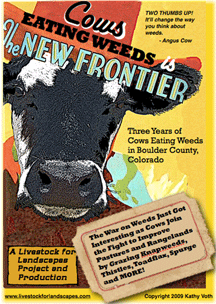



Herbicides may be doing more damage than good to our forage base.
Our traditional ideas about pasture and herbicides are that pastures should be primarily grass, and that herbicide damage to our pastures is nominal because they target only broad-leaf weeds and forbs. This project demonstrates that cattle with a broader view of what constitutes forage, can and will pick a diet heavy in forbs and light in grass. Five years of observing trainees indicates they also gain weight at expected rates, and in fact, in Marin County, California forb/weed eating cows gained more weight than their traditional grass-grazing herdmates.
By simply changing our minds about the role of forbs in a pasture based grazing system, we can solve weed problems and maintain or improve cattle productivity.
 |
Get a DVD summarizing three years of Cows Eating Weeds in Boulder County, ColoradoPerfect for introducing groupsto the idea that weeds can be nutritious forage |
Since 2007, I've been working with Boulder County Parks and Open Space and local ranchers to train a herd of 50 heifers and their offspring to eat late-season diffuse knapweed and Dalmatian toadflax. This year they taught me what cows trained to be open-minded about what food is can do. Not only did they teach herd mates to eat weeds, but they also showed me that grass may not always be a cow's first or best choice.
The herd grazed with 38 untrained cow-calf pairs in a 500-acre pasture, near Boulder, Colorado. June and July 2009 were two of the wettest months in history and grasses rebounded and forbs went wild. A large prairie dog ghost-town that covered about 200 acres of the pasture, was vacant because of plague. It was grassless, and covered in an assortment of weeds. It looked so bad from our accepted pasture paradigm that I nicknamed it the "garbage area."
But it didn't look bad to my weed-eating trained cows. They avoided the grassy areas and spent their time in the "garbage area" snipping off sunflower blossoms, yucca fruits, and musk thistle flowers and eating prickly lettuce and bindweed. When they came to grassy areas of blue grama, big bluestem, western wheatgrass and brome, cows grabbed a few bites then quickly moved on to graze prostrate pigweed, cutleaf nightshade, Russian thistle and fetid marigold. They dined on common ragweed, wormwood sagewort, wild licorice, assorted chinopodiums, Missouri goldenrod, and more.
I collected samples of the plants and plant parts cattle were eating and avoiding. Protein values for their preferred weeds ranged from 12 to 22%. Since we know that animals can choose foods based on nutrition, it makes sense that they were avoiding the grasses at 3 to 8% protein.
Download the 2009 Final Report - 1.6 MB

